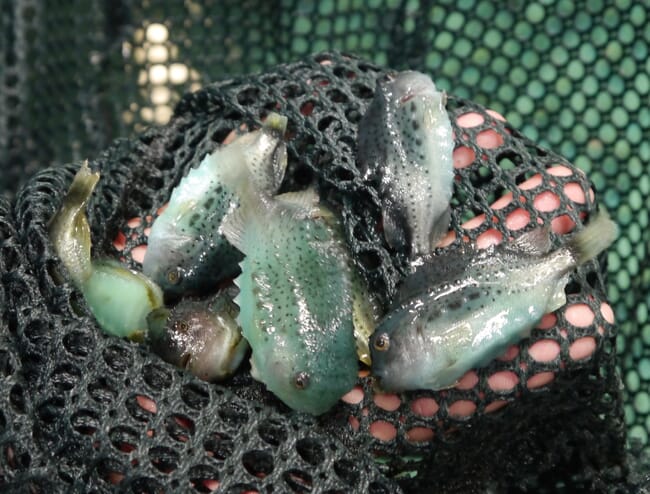
© Tom Morton
Introduction
As lumpfish (Cyclopterus lumpus L.) are a relatively new species in aquaculture, there are knowledge-gaps in husbandry techniques that often endanger their health and welfare. Although they seem to be prime candidates for controlling sea lice numbers in salmon farms, current farming conditions and procedures often compromise their health, and consequently their performance, rendering the fish ineffective and even raising welfare concerns.
A study conducted by the Norwegian Food Safety Authorities (Mattilsynet) revealed over 40 percent mortality of lumpfish deployed in Atlantic salmon net-pens in Norway. Worsening of lumpfish’s welfare status has also been reported after transportation and deployment to sea-pens, which can pose a significant stress. Conditions such as rapid cataract occurrence have also been demonstrated on lumpfish in sea cages, which may be associated by sub-optimal feeds and feeding strategies.
There is an urgent need of standardisation of methodology, such as in health monitoring, and the potential for improving lumpfish welfare by adopting strategies that safeguard lumpfish well-being. Health scoring is becoming an ever-more common practice, and is a valid method of inferring welfare status. Continuous health and welfare monitoring is essential to help identify when and what procedures and operations are detrimental, and thus, allow farmers to adapt and improve practices.
To encourage the adoption of health status monitorisation in a standardised, more comparable way, practical and user-friendly approaches are necessary. Operational welfare indicators (OWI) have been developed to assess health and condition for several farmed species, including lumpfish, and in a previous study (Imsland et al, 2020), the scoring system developed at Gifas was shown to be robust and reliable and gave an accurate indication of the health status of the fish.
This study used an updated version of the welfare scoring index designed and developed at Gifas (LHSS) to monitor health and welfare of ten groups of lumpfish delivered from three different hatcheries. LHSS is a complete system – with factsheets, a detailed descriptive manual and a model for evaluating scoring input and suggesting actions. The LHSS was created after analysing and comparing over 7,500 individual health assessments on lumpfish from previous studies conducted at Gifas, with individuals ranging from 5g up to 350g. These historical health datasets were compared with the corresponding growth and mortality datasets.
Study details
Assessment of the health status of all the lumpfish for each of the ten groups was assessed routinely using the Gifas LHSS. Three groups were maintained in land-based tanks, five groups were kept in 5x5x5m cages at our small-scale research site and two were stocked at commercial sites (table 1). Three of the groups were kept without salmon and the remainder were stocked with salmon. All groups were assessed within one week of arrival and, after which, routinely during each study.
The scoring systems focused on morphological health indicators. At each sampling point, all lumpfish from each cage had their weight and length recorded. The status of fins was scored, along with assessment of body condition, deformities/malformations, cataract/eye ulceration status and fitness (condition factor).
The assessment of health status was non-destructive, and lumpfish were returned to their specific cage after assessment. Each category has a specific “weight” in the final consideration of the overall health score. The specific attribution of an added “weight” for each category was decided and adjusted after appropriate testing with historical health datasets. The weighting criteria also considers some deteriorating conditions that are more severe than others and accordingly more weighting is applied in these instances. The input of score values in each category was calculated, giving a weighted health score for each fish.
The health index has two main components. The first is the scoring system itself and a group evaluation and action guide which recommends what steps to take, dependant on the severity of lumpfish welfare concerns.
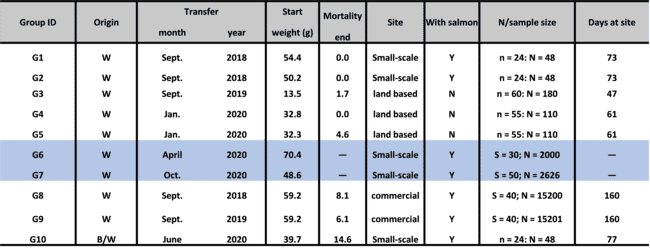
Results/Discussion
Health scoring baseline
On arrival, all groups were assessed, and all were found to have some form of damage – either to the tails, bodies or the eyes. Group 3 had the best health score whereas group 2 had the highest score, indicating a higher degree of external damage (figure 1). All groups scored within the area of minimal deterioration and no action was required at this point. The indicators which scored the highest (most damage) were found to be associated with tail damage and cataracts, whereas little or no deformities, body wounds or bad condition were found.
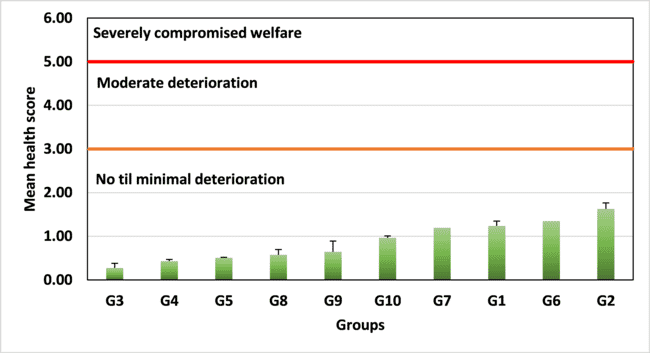
Fin damage
All groups were found with varying degrees of tail fin damage, varying from minimal to moderate. Fin condition is widely used as a practical indicator of health status as it is one of the earliest signs of health deterioration. Fin erosion and splitting can be attributed to many factors that often are associated, including physical injury due to bad handling, crowding, aggression between fish, poor nutritional status and stress. Active fin damage can escalate to a seriously compromised health status by being a gateway for opportunistic pathogens. Fins are scored for erosion, damage and splitting, based on the size of the area affected.
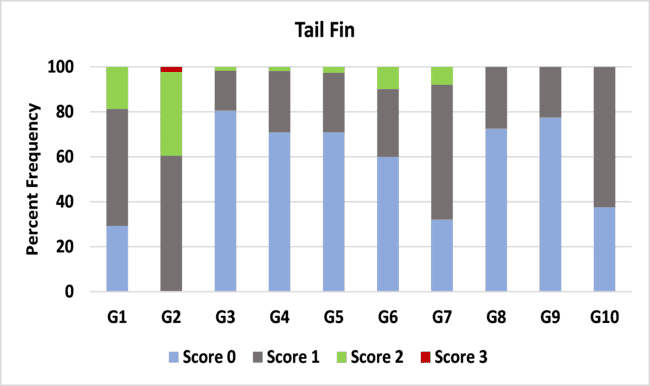
Cataract incidence
All groups had varying levels of cataract prevalence on arrival. Group 6 had the highest incidence of cataracts (83 percent of all fish) whereas group 3 had the lowest (1 percent). The incidence of cataracts was of the greatest welfare concern, as lumpfish require good eye health/condition to be able to see and graze sea lice. The prevalence of cataracts increased through time for all groups with prevalence ranging between 48 percent and 85 percent at the end of each study.
Recent anecdotal evidence has suggested that most hatcheries producing lumpfish have cataracts present during the pre-vaccination period of production, with prevalence varying greatly between them. It is also known that there are many different production strategies employed by hatcheries, some of which may contribute to cataract development. Currently, there is no detailed research being undertaken during this phase to fully elucidate the causal factors of cataract development. Importantly, if lumpfish are stocked in commercial salmon pens and have some degree of cataracts (Jonassen et al 2017), they could lose their ability to graze sea lice from salmon.
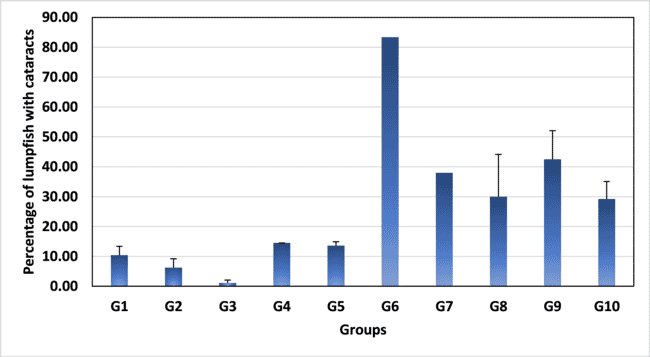
Health status through time
All groups showed deteriorating health status through time. Four of the groups had worsening health scores, approaching score 3, which triggers immediate action to attempt to stop health deteriorating more. For example, group 2 had a health score over 3 (figure 4) at day 73, which requires actions to improve health with potential sampling, such as histology and/or PCR, to determine causes of health deterioration. Health status can deteriorate quickly, particularly in sea cages, and welfare monitoring is of critical importance to aid in the maintenance of healthy populations.
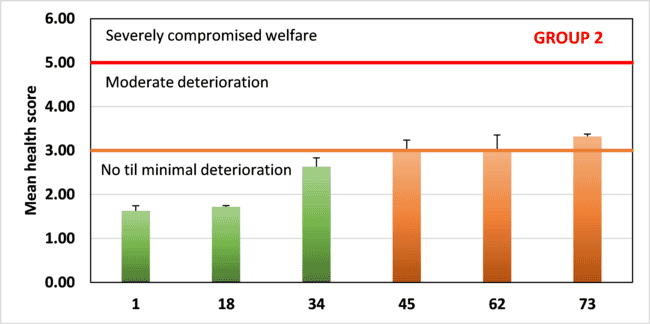
Conclusions
The health and welfare of cleaner fish such as lumpfish is of great concern and must be assessed throughout their life in aquaculture operations. Operational welfare indicators were developed for the fish used in this study, to follow the health changes throughout the study period for all the ten groups.
Although lumpfish seem to be prime candidates for controlling sea lice, current farming conditions and procedures often compromise their health, and consequently their performance, rendering the fish ineffective and even raising welfare concerns. Continuous health and welfare monitoring are essential to help identify when and what procedures and operations are detrimental, and thus allow farmers to adapt and improve their husbandry practices.
The results also indicate that health monitoring must occur during the hatchery phase, as well in sea cages. Thus, there is an urgent need for an industry-wide, systematic welfare scoring system.
An article is currently being written to describe the welfare scoring index used in this study in more detail.


